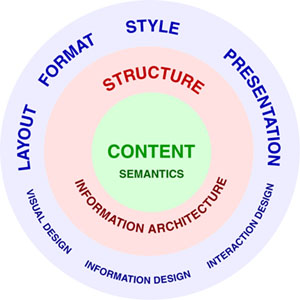 The three layers of content: the core text (XML),
The three layers of content: the core text (XML), the structure (XSD), and the style layer (XSL). XML further extends the amount of separation so that three basic things result: 1) the XML document containing the pure content itself, 2) a DTD or XML Schema Document (XSD) with the allowable structural elements and their attributes to validate the XML document, and 3) XSL style sheets (possibly XSL_FO and XSLT transformations) to convert the core content document to multiple output channels with different presentations. The three layers correspond to different types of markup. In the content core, the markup is semantic, with meaningful tags like name and price, the RDF properties that will drive the Semantic Web. In the structural layer, markup is syntactic, with tags like div and span. In the outer layer, markup is stylistic or presentational, with tags like font, b, and i. The layers also correspond to different professional skill sets - designers on the outside, architects building the middle layer, and content authors in the core. XSD, XML, and XSL are three components like the red, green, and blue signals of component television. Separating CSS from XHTML is, like S-Video, good but not HDTV. And finally, in an effort to make the objective of XML content-creation tools more readily understandable, here's a railroad metaphor: we can say the Developer Editor tools build the structure rail on one side (the content model) and the style rail on the other (the presentation model) that keep the author/editor on track with guided writing. Author or Developer? Both Second, your XML will need to be re-purposed to feed ever more types of output channels as you exploit multiple opportunities to publish your content. The XML Developer Editor will let your application developers design and build the several XSLT transformations that will be needed behind the scenes to publish your content. So now that we've framed the whys and wherefores of XML tools, it's time to take some out for a spin. Test Method We joined online company forums where they were offered and read some posts to get a sense of the user communities. We also joined independent mailing lists of user groups. When we encountered problems, we first Googled the error message or situation, then we sent in questions to vendor support. We found the company is usually a user's last resource for help. Once all the tools were installed, we created a test set of XML documents, XML schemas, and XSLT style sheets. We took them from CM Pros' Design Patterns for reporting Best Practices initiative and we simplified one of these to make a DITA XML test document. We recommend you follow a similar methodology, working with test documents drawn from your own content. If you have no structured content, you have three options:
Feature Evaluation For a sophisticated developer, any good text editor can be used to create XML documents, XML schemas, and XSLT style sheets. Among the most popular are HomeSite and UltraEdit (Windows), BBEdit (Mac), Emacs (Unix), and jEdit (cross-platform Java), our favorite tool. These typically have validation, tag-completion, elements in context, etc. And jEdit recognized the ditabase.dtd properly from its DOCTYPE declaration, where our reviewed XML Developer Editors surprisingly could not. Here are the key features we focused on in our examination of these tools: IDE. An XML Developer Editor that is the central part of an Integrated Development Environment is a must-have tool for any organization moving its content to XML. Since that now includes all content, at least one person in your organization needs an IDE. We judge the IDE tools by how many different aspects of XML they support. They should not only work with XML schemas and DTDs, they should provide full creation and debugging tools for these schemas. Perhaps even more important, they should let you design, debug, and deploy the many different style sheet transformations (XSLT) to repurpose your content for multichannel publishing. The best of them are part of a coordinated suite of tools that implement the many other options for XML development, which includes an alphabet soup of acronyms. 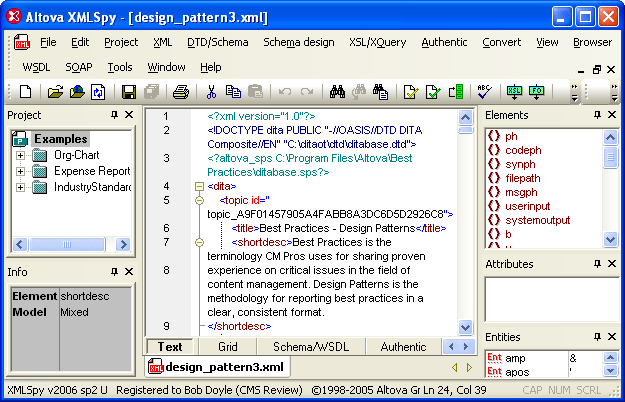 Altova’s source code view can switch to a Grid/Structure view, plus WYSIWYG (Authentic) view and a browser view
Altova’s source code view can switch to a Grid/Structure view, plus WYSIWYG (Authentic) view and a browser view
WYSIWYG. A simple XML Author tool that enforces the structural and styling constraints of XML schemas and XSL transformations can do this without revealing complex behind-the-scenes machinery. It should provide a comfortable and familiar interface for content creators used to working in standard what-you-see-is-what-you-get word processors. If the ratio of content creators to content editors and designers is high, you will need many more XML Author tools than XML Editor tools. Validation. Guided writing, or structured authoring, works best when the writer is constantly assisted in doing the right thing. The ideal is continuous real-time validation against the content model rules in the schema. Even more rigid is to not allow the possibility of error. So validation comes in a range of settings. It can be turned off for experts. It may be done by clicking a request for validation. It may provide only warnings. It may actually correct or prevent errors. Some tools only allow both start and end tag sets to be inserted. Elements in context. When adding structural elements, the best tools display a context-dependent list of the "allowed" or "available" elements that can be added at the current insertion point in the document. This can be in a separate window pane or a floating palette, a drop-down menu when you type an open tag, or revealed by right-clicking at the insertion point. Some Editors allow you to turn this down, or completely off for power users. Tags-on view. Though they disrupt the pure WYSIWYG look, optional visual representations of the start and end tags for structural elements are very helpful. Structure, or Tree, view. A hierarchical view of the document, which expands and contracts elements like an outline tool, letting you move around quickly in large documents. More powerful Editors let you move structural elements in this view and synchronize changes with other views. Grid view. An arrangement of your content in something like spreadsheet cells. Cells can be moved, preserving their internal structure. Drag/drop structure. The best Editors allow selection of the whole structural element, then drag-and-drop of the element - only to locations that are valid for the specific element, of course. 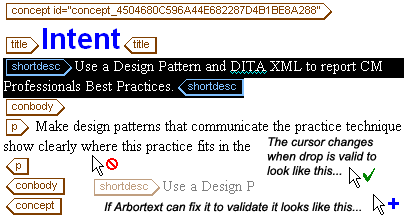 In Arbortext Editor we have selected a short description element in our
In Arbortext Editor we have selected a short description element in our DITA document and are dragging it. The red "stop/no parking" symbol indicates shortdesc is not allowed inside the paragraph element. Arbortext will let you drop an invalid element if it thinks it can make it valid after you drop it, in which case the symbol is a blue "plus" sign. Source-code view. Some pure WYSIWYG Editors can show the source code for changes best made while looking at the XML source. Top tools highlight the syntax with your choice of colors so authors can easily distinguish the code from the content. Tag auto-completion. When typing tags yourself, auto-completion is one way of enforcing correct structure. Line indenting. Source code that is hard to scan quickly is useless. The best tools indent child elements to reveal the document structure. They may do this as you type or on-demand. But watch out for tools that add white space where you don't want them in mixed XML content. They should "roundtrip" your code cleanly. XSLT processor. Built-in XSLT processing lets you view the multiple transforms to publishing output channels. XPath/XQuery. Quickly find elements anywhere in a document that share a property and may be targets for special repurposing in your XSLT outputs. Some tools populate the XPath with your contextual position. As you click in the document your XPath appears automatically in the search box. Native XML databases. Berkeley and eXist databases store your XML as is. Many content management systems do as well. Specific schemas. Support for well-known XML "vocabularies" like DocBook, DITA, etc. Support also for different schema standards, like DTD, XSD (XML Schema Document), Relax NG, NRL, etc. DITA. The Darwin Information Typing Architecture standardizes schema components that can be specialized to a variety of technical documentation needs. DocBook. While DITA accomplishes most of what the SGML DocBook standard provides, some tools continue support for DocBook. Package size. The amount of code downloaded gives you some idea of the amount of work put into these great tools. Communities online. Judging a book by its cover is a bad idea, but listening to what users are saying about these tools is a solid criterion for judgement. Google PageRank. Another objective measure of a company is its Google ranking on a logarithmic scale from one to ten. Note that every additional step up in rank means roughly ten times the importance of the site. Templates. A library of "stationery" resources, XML documents that authors can start with, knowing they are valid for certain schemas and support specific output style sheets. Developer tools. All our Developer tools can extract schemas from well-formed XML documents. Some offer visual schema designers. Some provide schema management to assist in the creation of compound XML documents that contain elements from diverse schemas and namespaces, e.g., Dublin Core, SVG (scalable vector graphics), MathML, etc. Some visual XSLT style sheet designers are synchronized with their code view. Look for new XSLT 2.0 support. 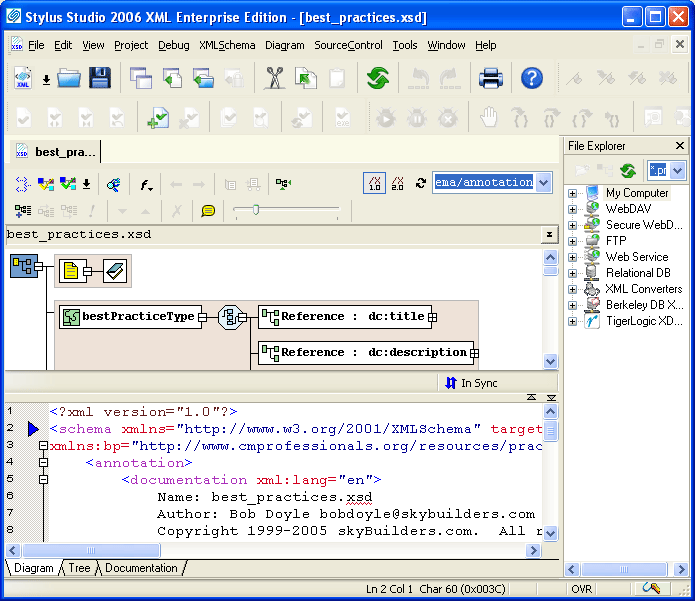 The visual design view above is synchronized with the source code view.
The visual design view above is synchronized with the source code view.
Spell check. This can range from simple checking with a customizable word list to dynamic word and phrase completion to insure that writers use terminology consistently throughout the organization. Multilingual. Unicode support for integration with translation tools. There are other important features you should evaluate when considering the selection of an XML tool; however, we didn't include these in our matrix because all 12 tools we evaluated have them. |
|||||||||||||||||||||||||||||||||||||||||||||||||||||||||||||||||||||||||||||||||||||||||||||||||||||||||||||||||||||||||||||||||||||||||||||||||||||||||||||||||||||||||||||||||||||||||||||||||||||||||||||||||||||||||||||||||||||||||||||||||||||||||||||||||||||||||||||||||||
INTRODUCING THE XML AUTHOR EDITORS 
Adobe FrameMaker 7.2 
PTC Arbortext Editor 5.2 with Styler 
XMetaL Author 4.6 DITA Edition 
Syntext Serna 2.5 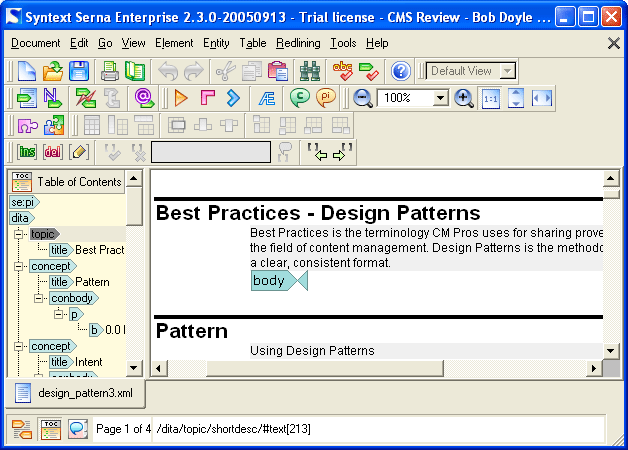 Serna’s tags-on view synchronizes with the Tree/Structure view on the left.
Serna’s tags-on view synchronizes with the Tree/Structure view on the left.
INTRODUCING THE XML DEVELOPER EDITORS 
Cladonia Exchanger XML 3.2 
Stylus Studio 2006 
SyncRO Soft <oXygen> 7.1  Note the XPath 2.0 query box. Here we are importing the Dublin Core schema.
Note the XPath 2.0 query box. Here we are importing the Dublin Core schema.
INTRODUCING THE XML AUTHOR AND DEVELOPER EDITOR 
Altova XMLSpy/Suite 2006 BROWSER-BASED XML AUTHOR EDITORS We briefly looked at four browser-based XML Author tools, but difficulties integrating them into the necessary Web server and CMS prevented us from studying them properly at this time. Worth a look are Ektron eWebEditPro + XML, integrated with Ektron's CMS400.NET, and top CMSs like Documentum, FatWire, Interwoven, Microsoft, Percussion, SilkRoad, and Vignette; Ephox EditLive! for XML, a Java applet that specializes in XML output from form-style Web pages to feed data into your XML publishing stream; XMAX (XMetaL for ActiveX), an IE plug-in; and Xopus, written entirely in JavaScript and adaptable to most any CMS on the backend. Xopus is integrated into Arbortext Publishing Engine as its Contributor product. All these are WYSIWYG Style interfaces that your content contributors can work with. But remember that none of them will work without skilled application developers integrating them into your publishing system with XML Schema Documents and XSLT style sheets. For this they will need an XML Developer Editor (IDE) tool. OASIS/IBM DITA Open Toolkit |
|||||||||||||||||||||||||||||||||||||||||||||||||||||||||||||||||||||||||||||||||||||||||||||||||||||||||||||||||||||||||||||||||||||||||||||||||||||||||||||||||||||||||||||||||||||||||||||||||||||||||||||||||||||||||||||||||||||||||||||||||||||||||||||||||||||||||||||||||||
|
XML DEVELOPER EDITOR AND AUTHOR EDITOR FEATURE MATRIX
BROWSER-BASED XML AUTHOR/EDITOR FEATURE MATRIX
CONCLUSION And the winners are . . . all of you who are thinking of moving your content to XML!Every one of our XML Author Editors and Developer Editors can be downloaded for 30-day trials so you can see for yourself our reasons for selecting them. It's an amazing no-risk deal. The only cost is your time; hands-on experience will be much more informative than this brief article. Start with the one that appeals most, but please do work with the others. Many vendors provide excellent sample files and tutorials that will help you to understand the complete XML content-publishing process. Only after I had studied a few of them did I scratch the surface on how powerful they all are. I don't think you can make your wisest selection without going from XML document to PDF or Web page in most of these eight tools. Yes, content remains king. But without the structure, format, layout, and presentation made possible by XML schemas and style sheets, it's more like an emperor with no clothes. Other Companies Featured in this Article EMC Documentum www.documentum.comFatWire Corporation www.fatwire.com IBM Corporation www.ibm.com Integrated Technologies, Inc. www.intech.com Interwoven, Inc. www.interwoven.com Justsystems www.justsystems.com Mekon, Ltd. www.mekon.com Microsoft Corporation www.microsoft.com Oasis www.oasis.org SilkRoad Technology, Inc. www.silkroadtech.com Vignette Corporation www.vignette.com | |||||||||||||||||||||||||||||||||||||||||||||||||||||||||||||||||||||||||||||||||||||||||||||||||||||||||||||||||||||||||||||||||||||||||||||||||||||||||||||||||||||||||||||||||||||||||||||||||||||||||||||||||||||||||||||||||||||||||||||||||||||||||||||||||||||||||||||||||||





 Ektron eWebEditPro + XML
Ektron eWebEditPro + XML Ephox EditLive! For XML
Ephox EditLive! For XML  Xopus
Xopus 


